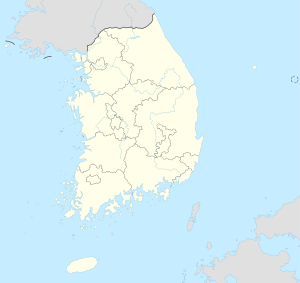Yeoju
| Yeoju | |||
|---|---|---|---|
| Korean alphabet : | 여주 시 | ||
| Chinese characters : | 驪 州市 | ||
| Revised Romanization : | Yeoju-si | ||
| McCune-Reischauer : | Yŏju-si | ||
| Basic data | |||
| Province : | Gyeonggi-do | ||
| Coordinates : | 37 ° 18 ' N , 127 ° 38' E | ||
| Surface: | 608.6 km² | ||
| Residents: | 114,659 (as of 2019) | ||
| Population density : | 188 inhabitants per km² | ||
| Structure: | 1 eup , 8 myeon , 3 dong | ||
| map | |||
|
|||
Yeoju ( 여주 ) is a city in Gyeonggi-do Province in South Korea . The city has a population of over 114,000 and is located in the Sudogwon region . Yeoju was a county until September 2013 when it was eventually elevated to a city.
history
There have been human settlements in the Yeoju area since the Paleolithic. Fragments of herringbone pottery, ax heads and other artifacts have been discovered at the Heunam-ri archaeological site, southeast of the city proper. Because of its location on the Namhan River. Yeoju was a geographically strategic point for the rulers of the Silla Kingdom . During the reign of King Pasa 5th ruler of Sillas from 80-112 AD, the mountain fortress Pasaseong-ji was built just downstream from Yeoju on Mount Pasa.
Yeoju continued to be important during the Joseon Dynasty as it was a major agricultural producer of staple foods such as rice. Various laws were passed throughout the dynasty to increase agricultural production and improve the quality of rice, which led to Yeoju and the nearby neighboring town of Icheon becoming the center of cultivation.
The tomb of Sejong the Great , the most influential king in Korean history, was relocated to Yeoju from its previous location in Seoul in 1469. The tomb remains one of the region's greatest tourist attractions.
In 1851, towards the end of the Joseon Dynasty, the last Queen of Korea Myeongseong was born in Yeoju . Her birthplace, Gamgodang, was largely destroyed during the Japanese occupation, but it was rebuilt in her honor after the country was liberated.
economy
Together with the neighboring city of Icheon, it is known as an important center for contemporary South Korean ceramics and hosts the World Ceramic Exposition every year. Other important local products are rice, sweet potatoes and yellow melons.
Infrastructure
The Expressway 45 runs through the town. The city is also connected to the Seoul subway system .
education
The city is home to the Yeoju Institute of Technology , which has been a university since 2012.
sons and daughters of the town
- Myeongseong (1851–1895), last queen of the Joseon dynasty
Individual evidence
- ^ Statistics Korea. Retrieved October 30, 2019 .
- ↑ VoS: World Ceramic Exposition Foundation. Retrieved March 15, 2020 .

